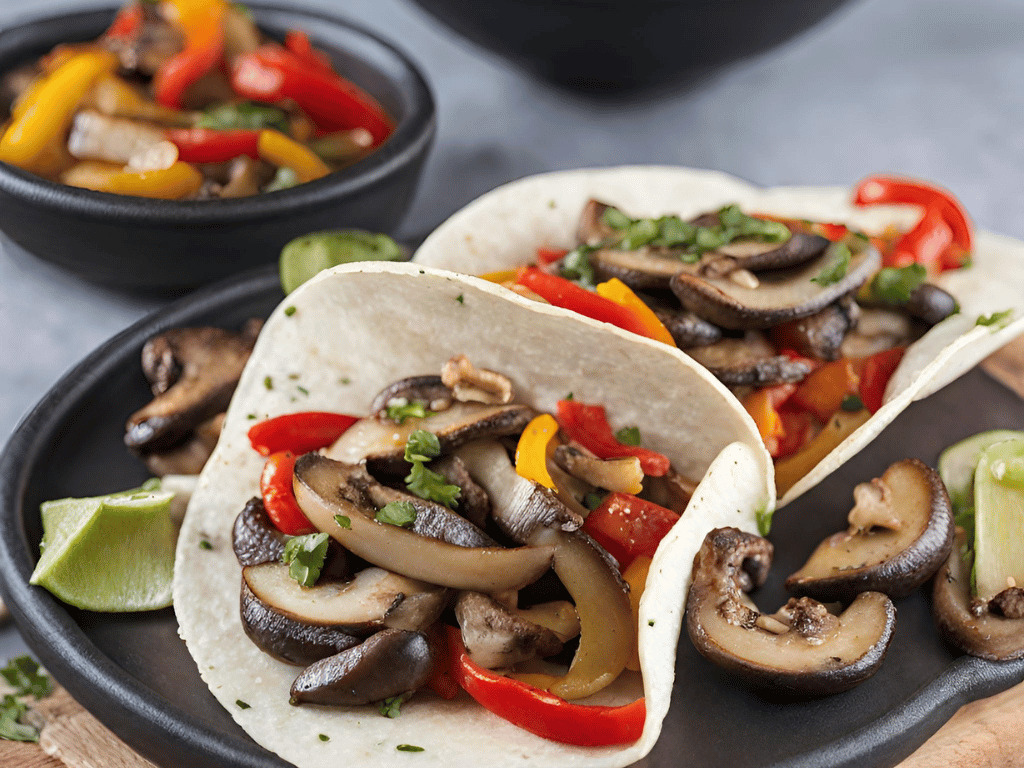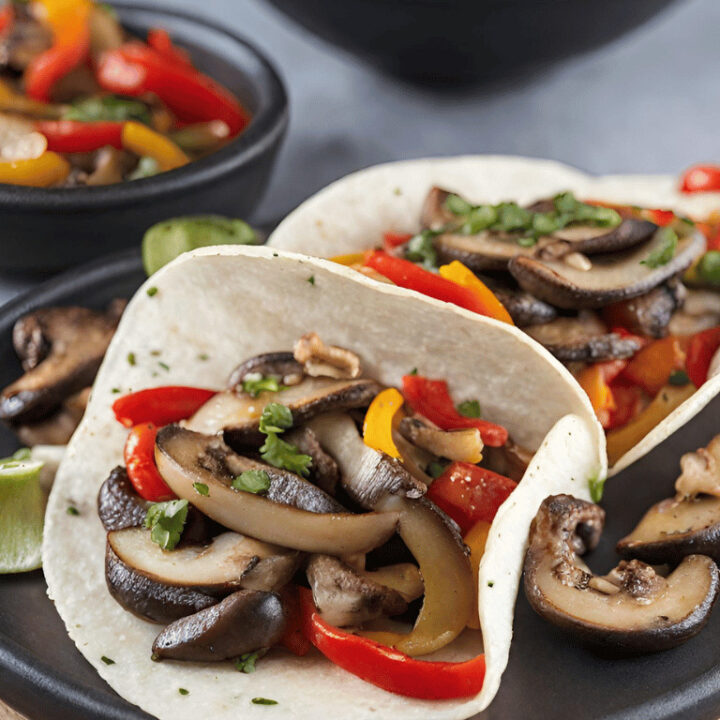Cumin and paprika liven up veggies to make these mushroom, pepper, and onion fajitas a delicious and vegetarian-friendly twist on the classic meat fajita.

Veggie fajitas are a nutritious and delicious alternative to meat fajitas. However, fajitas have a long history in Mexican and Tex-Mex cuisine and continue to be a favorite in restaurants across the United States.
The history of fajitas is closely tied to Mexican and Tex-Mex cuisine, and the dish has an interesting and somewhat debated origin. The term “fajita” itself is believed to have originated from the Spanish word “faja,” which means “belt” or “girdle,” referring to the skirt steak cut of beef commonly used in the dish.

One popular legend attributes the invention of fajitas to Mexican ranch workers (vaqueros) in the 1930s or 1940s. According to this story, the workers were given the less desirable cuts of meat, such as the skirt steak, as part of their pay. To make the tough meat more palatable, they would marinate it in lime juice and cook it over an open fire. The grilled meat would then be wrapped in flour tortillas and served with condiments like guacamole, salsa, and sour cream.

Another story suggests that the origin of fajitas can be traced to the ranchlands of West Texas, particularly the Rio Grande Valley. In the mid-20th century, Mexican cowboys, or vaqueros, working in Texas would butcher cattle and take the inexpensive, tough cuts of meat to cook over an open flame. They would slice the meat into strips, cook it quickly, and wrap it in flour tortillas for a convenient and flavorful meal.

In the 1960s and 1970s, fajitas gained popularity in the United States, particularly in Texas. They were introduced to a wider audience through the efforts of Sonny Falcon, a meat market manager in Kyle, Texas, who began packaging and selling pre-marinated and pre-cooked fajita meat. Restaurants in Texas soon started serving fajitas, and their popularity spread throughout the country.

Fajitas became a staple in Tex-Mex restaurants, and variations with chicken, shrimp, and other proteins became common. Today, fajitas are enjoyed worldwide, and they are often a popular choice in Mexican and Tex-Mex cuisine, served with a variety of accompaniments such as grilled vegetables, rice, beans, and traditional condiments.

Veggie fajitas, made with a variety of grilled or sautéed vegetables, can offer numerous health benefits. Here are some potential advantages:
- Nutrient-Rich: Vegetables are rich in essential nutrients such as vitamins, minerals, and antioxidants. They provide a wide range of nutrients that are beneficial for overall health.
- Fiber Content: Vegetables are an excellent source of dietary fiber, which is important for digestive health. Fiber can help regulate bowel movements, lower cholesterol levels, and contribute to a feeling of fullness, aiding in weight management.

- Low in Calories: Compared to meat-based fajitas, veggie fajitas tend to be lower in calories and saturated fats. This can be beneficial for those looking to manage their weight or reduce their intake of certain dietary fats.
- Heart Health: A diet rich in vegetables is associated with a lower risk of heart disease. The fiber, potassium, and antioxidants found in vegetables contribute to heart health by helping to regulate blood pressure and reduce inflammation.

- Reduced Environmental Impact: Choosing veggie fajitas over meat-based options can have a lower environmental impact. Plant-based diets generally require fewer natural resources, such as water and land, and produce fewer greenhouse gas emissions compared to meat production.
- Blood Sugar Control: Some vegetables, especially those with a low glycemic index, can help regulate blood sugar levels. This can be particularly beneficial for individuals with diabetes or those looking to manage their blood sugar.
- Versatility: Veggie fajitas can be made with a variety of colorful vegetables, providing a diverse array of flavors and textures. This variety not only enhances the taste but also ensures a broad spectrum of nutrients.

- Digestive Health: The fiber in vegetables promotes a healthy gut microbiome, which is essential for digestion and overall gut health. A balanced and diverse microbiome is associated with various health benefits.
- Anti-Inflammatory Properties: Many vegetables, especially those rich in antioxidants, have anti-inflammatory properties. Chronic inflammation is linked to various health conditions, so including anti-inflammatory foods in your diet can be beneficial.
- Vegan and Vegetarian-Friendly: Veggie fajitas are suitable for individuals following vegan or vegetarian diets. They offer a delicious and satisfying option without the need for meat.

When preparing veggie fajitas, consider using a variety of vegetables such as bell peppers, onions, zucchini, mushrooms, and tomatoes. Adding flavorful spices and herbs can enhance the taste without the need for excessive salt or unhealthy condiments. Overall, veggie fajitas can be a tasty and nutritious addition to a balanced diet.

Veggie Fajitas
Mushroom, pepper, and onion fajitas are a delicious and vegetarian-friendly twist on the classic fajitas.
Ingredients
- 2-3 bell peppers, sliced (yellow, red, orange, or green)
- 1 large onion, sliced
- 8 ounces mushrooms, sliced
- 3 cloves garlic, minced
- 1 teaspoon ground cumin
- 1 teaspoon chili powder
- 1/2 teaspoon smoked paprika
- Salt and pepper, to taste
- Juice of 1 lime
- 8 small flour tortillas
- Optional toppings: salsa, guacamole, sour cream, shredded cheese, chopped cilantro
Instructions
- Heat olive oil in a large skillet over medium-high heat.
- Add sliced bell peppers and onions to the skillet. Sauté for 3-4 minutes until they begin to soften.
- Add sliced mushrooms to the skillet and continue to cook for an additional 3-4 minutes until the mushrooms are tender.
- Stir in minced garlic, ground cumin, chili powder, smoked paprika, salt, and pepper. Cook for an additional 1-2 minutes until the spices are fragrant.
- Squeeze the juice of one lime over the vegetable mixture and stir to combine.
- Wrap the tortillas in batches of 4 for 20 seconds on high.
- Assemble the fajitas by placing a generous portion of the vegetable mixture onto each tortilla.
- Serve with optional toppings such as salsa, guacamole, sour cream, shredded cheese, and chopped cilantro.


